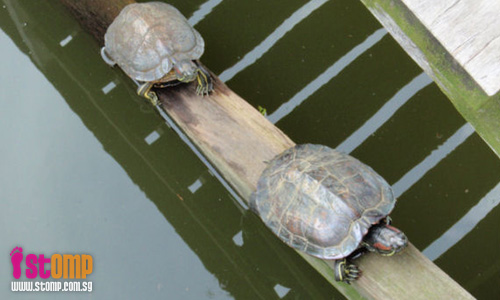
A STOMPer sent in pictures of different types of swans he saw at the Botanic Gardens.
In an email to STOMP today (April 14), the STOMPer says:
"These pictures were taken at the Singapore Botanic Gardens.
"A male swan is called a cob, a female swan is called a pen and a baby swan is called a cygnet.
"The swan is the largest aquatic bird and it moves gracefully in water. It is long-necked and web-footed. In the picture, you can see a tortoise and two black swans.
"The swan has a red beak and black swans are only found in the Eco Lake in our Botanic Gardens.
"The white swan (as seen in the picture) is found in the Swan Lake nearer to Napier Road. You can see its reflection in the water.
"In one of the pictures, you can also see two tortoises. After swimming in the water, they decided to dry themselves on the wooden plank beside the wooden bridge.
"The Swan Lake is very peaceful in the early morning. Sometimes you can see newlyweds coming here with their photographers to take some photos of their most memorable day."



When will this particular person learn that the red-eared slider (Trachemys scripta elegans) is a turtle, not a tortoise?
The mute swan (Cygnus olor) is the species that most commonly comes to mind when we think of swans. A native of much of Europe and Central Asia, it has been introduced to other parts of the world, most notably in North America, where it has stirred up a fair bit of controversy; to some, it is a non-native species whose numbers should be controlled by culling, a view that faces much opposition from animals rights organisations and many individuals.
The black swan (Cygnus atratus), on the other hand, hails from Australia, and has recently established itself in New Zealand due to deliberate introduction as an ornamental bird, and also via natural dispersal from Australia. However, a prehistoric subspecies of black swan once existed on New Zealand and the Chatham Islands, but disappeared possibly due to hunting by human settlers. The black swan is also commonly reared in Europe.
There are 4 other species of swan, but they are much more rarely seen in captivity. They are the black-necked swan (Cygnus melancoryphus) of southern South America, the whooper swan (Cygnus cygnus) of northern Eurasia, the trumpeter swan (Cygnus buccinator) of North America, and the tundra swan (Cygnus columbianus) of both North America and northern Eurasia.
As mentioned by the person who submitted the post to STOMP, the 2 species of swan of the Singapore Botanic Gardens actually reside in different areas; the mute swans live at the Swan Lake, while the black swans are found over at the Eco-Lake.